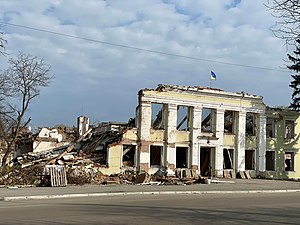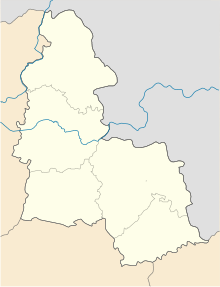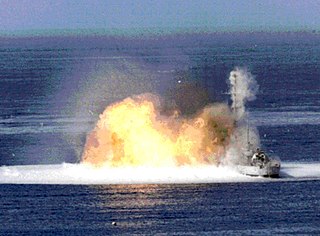
A thermobaric weapon, also called an aerosol bomb, or a vacuum bomb, is a type of explosive munition that works by dispersing an aerosol cloud of gas, liquid or powdered explosive. The fuel is usually a single compound, rather than a mixture of multiple molecules. Many types of thermobaric weapons can be fitted to hand-held launchers, and can also be launched from airplanes.

Okhtyrka is a city in Sumy Oblast, Ukraine. It serves as the administrative center of Okhtyrka Raion within the oblast. Okhtyrka was once home to Hussars and Cossacks. It was also in the past a regional seat of the Sloboda Ukraine Imperial Region and of the Ukrainian SSR. Since the discovery of oil and gas in 1961, Okhtyrka has come to be known as the "Oil Capital of Ukraine." It is home to the Okhtyrka air base and other historical and religious sites. Some religious buildings in Okhtyrka were almost destroyed in the Russian invasion of Ukraine.

Trostianets is a city in Okhtyrka Raion of Sumy Oblast of northeastern Ukraine. It was the administrative center of Trostianets Raion until it was abolished on 18 July 2020. The city lies on the Boromlya River, 59 km (37 mi) from Sumy. Landmarks include a neo-Gothic "round courtyard" (1749), the late Baroque church of the Annunciation (1744–50), the 18th-century Galitzine palace, and a "grotto of nymphs". The city has a population of 19,544.
Velyka Pysarivka is a rural settlement in Sumy Oblast, northeastern Ukraine. It was formerly the administrative center of Velyka Pysarivka Raion, but is now administered within Okhtyrka Raion. It is located close to the border with Russia, on the left bank of the Vorskla, a tributary of the Dnieper. Population: 3,928.

The battle of Kharkiv was a military engagement that took place from February to May 2022 in and around the city of Kharkiv in Ukraine, as part of the eastern Ukraine offensive during the 2022 Russian invasion of Ukraine. Kharkiv, located just 30 kilometres (19 mi) south of the Russia–Ukraine border and a predominately Russian-speaking city, is the second-largest city in Ukraine and was considered a major target for the Russian military early in the invasion.
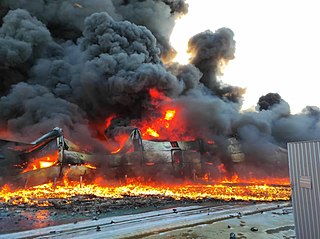
On 24 February 2022, the Russian army attempted to capture Sumy, located near the Russia–Ukraine border. Ukrainian paratroopers and territorial defense forces began engaging Russian forces within the city, resulting in heavy urban fighting and the destruction of a Russian tank column. That evening, Ukraine's paratroopers were ordered to withdraw from the city, leaving the city's defense to the a few thousand local volunteers armed with rifles, limited anti-tank weapons and no armed vehicles or heavy weaponry. After three to four days of failing to enter the city, the Russian military shifted to encircle and bypass the city, and were then subject to guerrilla ambushes.

The northern Ukraine campaign was a theater of operation in the Russian invasion of Ukraine. It involved attacks by Russia across the Russo-Ukrainian and Belarusian–Ukrainian borders, beginning on 24 February 2022, for control of Kyiv, the capital of Ukraine, and the surrounding areas of Kyiv Oblast and northern regions Zhytomyr Oblast, Sumy Oblast, and Chernihiv Oblast. Kyiv is the seat of the Ukrainian government and the headquarters of the Armed Forces of Ukraine.

The battle of Kyiv was part of the Kyiv offensive in the Russian invasion of Ukraine for control of Kyiv, the capital city of Ukraine, and surrounding districts including Hostomel Airport. The combatants were elements of the Russian Armed Forces and Ukrainian Armed Forces. The battle lasted from 25 February 2022 to 2 April 2022 and ended with the withdrawal of Russian forces.

The siege of Mariupol began on 24 February 2022 and lasted until 20 May, as part of the Russian invasion of Ukraine. It saw fighting between the Russian Armed Forces and the Ukrainian Armed Forces for control over the city of Mariupol in southeastern Ukraine. Lasting for almost three months, the siege ended in a victory for Russia and the Donetsk People's Republic, as Ukraine lost control of the city amidst Russia's eastern Ukraine offensive and southern Ukraine offensive; all Ukrainian troops remaining in the city surrendered at the Azovstal Iron and Steel Works on 20 May 2022, after they were ordered to cease fighting.
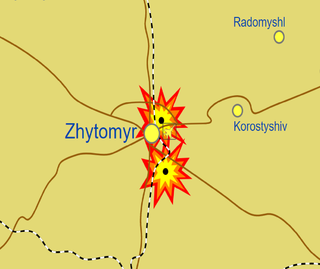
Missile attacks on Zhytomyr began on 24 February 2022 as part of the Russian invasion of Ukraine.

Hero City of Ukraine is a Ukrainian honorary title awarded for outstanding heroism during the 2022 Russian invasion of Ukraine. It was awarded to ten cities in March 2022, in addition to four already-named Hero Cities of the Soviet Union. This symbolic distinction for a city corresponds to the distinction of Hero of Ukraine awarded to individuals.

On 16 March 2022, a Russian attack killed at least 18 and injured 26 civilians in Chernihiv, Ukraine, who were waiting in a line for bread.
A series of clashes began on 26 February 2022 around the city of Lebedyn, Sumy Oblast, during the 2022 Russian invasion of Ukraine.

The Russian occupation of Sumy Oblast was a military occupation that began on 24 February 2022, when Russian forces invaded Ukraine and began capturing parts of the Sumy Oblast. The capital of the Oblast, Sumy, was never captured by Russian forces, however, other cites were captured including Konotop and Trostianets. On 7 April, Dmytro Zhyvytskyi, governor of Sumy Oblast, said that all Russian troops had left the region, but it was still unsafe due to rigged explosives and other ammunition Russian troops had left behind.
A series of border skirmishes has taken place along the Russia–Ukraine border in Sumy and Chernihiv Oblasts since the withdrawal of Russian troops from northern Ukraine. Ukrainian officials have stated that strikes across the border happen daily.
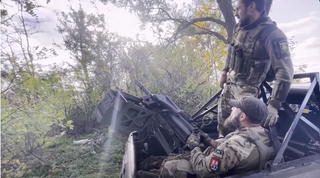
The battle of Huliaipole is an ongoing military conflict between the Armed Forces of Russia and the Armed Forces of Ukraine over the city of Huliaipole, in central Zaporizhzhia Oblast.

During the Russian invasion of Ukraine, the Russian military have carried out deliberate attacks against civilian targets and indiscriminate attacks in densely-populated areas. The United Nations Human Rights Monitoring Mission in Ukraine says the Russian military exposed the civilian population to unnecessary and disproportionate harm by using cluster bombs and by firing other weapons with wide-area effects into civilian areas, such as missiles, heavy artillery shells and multiple launch rockets. As of 2024, the attacks had resulted in the UN-documented deaths of between 11,000 and estimated 40,000 dead civilians. On 22 April 2022, the UN reported that of the 2,343 civilian casualties it had been able to document, it could confirm 92.3% of these deaths were as a result of the actions of the Russian armed forces.

The Russian occupation of Kyiv Oblast was a military occupation that began on the first day of the Russian invasion of Ukraine on 24 February 2022. The capital, Kyiv, was extensively bombed during the invasion, but was never captured. However, many cities were captured near northern and western parts of the oblast.

The battle of Kupiansk was a part of the Ukrainian Kharkiv counteroffensive that began on 8 September 2022 and ended on 16 September 2022. A Financial Times article on 28 September depicted the battle and the Ukrainian advance preceding it as "the 90km journey that changed the course of the war in Ukraine."
This timeline of the Russian invasion of Ukraine covers the period from 24 February 2022, when Russia launched a military invasion of Ukraine, to 7 April 2022 when fighting focused away from the north and towards the south and east of Ukraine.
